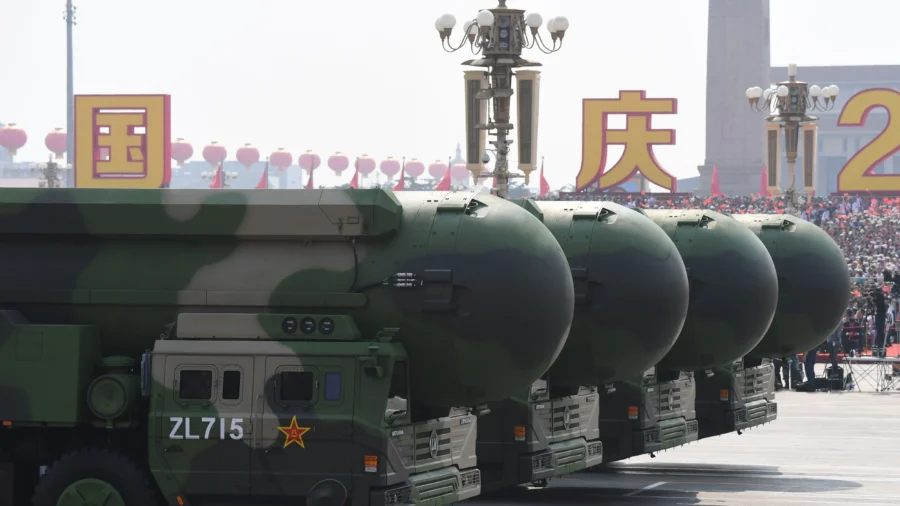Communist China’s officials will likely be more confident in countering the United States over the next decade, as the regime is pursuing the “most rapid expansion” of its nuclear arsenal in history, according to a new assessment published by the Pentagon’s intelligence agency on Oct. 23.
The Defense Intelligence Agency (DIA) said in its 2024 “Nuclear Challenges” report that China currently has more than 500 operational nuclear warheads and will have at least 1,000 by 2030. These numbers remain on par with past Pentagon estimates.
“China is undergoing the most rapid expansion and ambitious modernization of its nuclear forces in history—almost certainly driven by an aim for enduring strategic competition with the U.S.,” the report reads.
“China probably will introduce new capabilities which carry the potential to destabilize the status quo over the next decade as it develops concepts for new systems’ use and integrates them into its broader warfighting and deterrence doctrine.”
Most of the growing number of nuclear warheads will be capable of hitting the continental United States, the DIA estimated, noting that China “probably also seeks lower-yield nuclear warhead capabilities” for warning and deterrence regionally. For instance, China is adding to its stockpiles of “theater-range delivery systems,” such as the DF-26 intermediate-range ballistic missile, the report says.
According to a 2023 China military report from the Pentagon, the DF-26 has an estimated range of about 1,860–2,485 miles and can hit Guam.
China’s rocket forces will likely account for most of its increased stockpiles, such as a silo-based solid-propellant missile project, a silo-based liquid-propellant missile expansion, and the establishment of more mobile intercontinental ballistic missile (ICBM) brigades.
Ultimately, the Chinese regime will likely seek a “diverse nuclear force” to ensure that it “can inflict unacceptable damage with both proportionate and overwhelming retaliatory capabilities,” the report says.
“Beijing probably would also consider using its nuclear force if a conventional military defeat in Taiwan gravely threatened the regime’s survival,” the report says, citing the Pentagon’s 2023 report.
The 2023 Pentagon report discusses how the Chinese regime would respond to U.S. intervention in the event the regime launched an attack on Taiwan. Initially, the People’s Liberation Army (PLA) would try to “delay and defeat the intervention in a limited war of short duration,” it says.
“In the event of a protracted conflict, the PLA might choose to escalate cyberspace, space, or nuclear activities in an attempt to end the conflict, or it might choose to fight to a stalemate and pursue a political settlement,” it states.
Last month, China test-fired an ICBM into the Pacific Ocean, raising concerns among countries in the region, including China’s diplomatic ally Kiribati.
U.S. Air Force Secretary Frank Kendall, in a keynote address at an Air & Space Forces Association convention in September, discussed the threats posed by China’s nuclear arsenal.
“The Chinese expansion of its nuclear arsenal has reinforced the importance of the strategic triad. Both the B-21 and the Sentinel Program are essential contributors to our strategic deterrent,” Kendall said.
The Sentinel ICBM program aims to replace the aging Minuteman III nuclear missiles with new ICBMs.
Air Force Chief Master Sgt. David Flosi characterized China as a “systematic threat” to the United States and its allies in his keynote address at the Air & Space Forces Association convention.
“The PRC’s [People’s Republic of China’s] goal is to replace the U.S.-led rule-based world order with one lead and dictated by the Chinese Communist Party,” Flosi said.
Flosi emphasized that the Chinese military and the U.S. military are fundamentally different.
“The People’s Liberation Army, the PLA for short, is the armed wing of the Chinese Communist Party. While we are sworn to protect and defend the Constitution of the United States, the PLA is sworn to protect the Chinese Communist Party. Not the Chinese people, not the country,” he said.
From The Epoch Times

